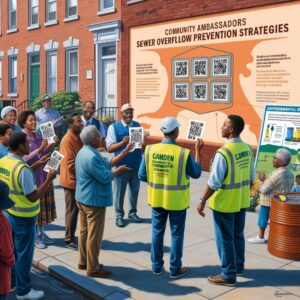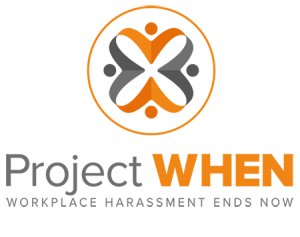Collaborating for Change: How Strategic Communication and Community Partnerships Revitalized Camden, New Jersey’s Environment
 Effective environmental reform requires more than engineering—it demands meaningful communication, community trust, and cross-sector collaboration. The Camden Collaborative Initiative (CCI) led by the City of Camden, New Jersey Department of Environmental Protection (NJDEP), Camden County, Cooper’s Ferry Partnership, and over 60 other public, private, and nonprofit stakeholders demonstrates how strategic communication can power a community-led transformation of environmental justice, public health, and land revitalization.
Effective environmental reform requires more than engineering—it demands meaningful communication, community trust, and cross-sector collaboration. The Camden Collaborative Initiative (CCI) led by the City of Camden, New Jersey Department of Environmental Protection (NJDEP), Camden County, Cooper’s Ferry Partnership, and over 60 other public, private, and nonprofit stakeholders demonstrates how strategic communication can power a community-led transformation of environmental justice, public health, and land revitalization.
Through resident-centered messaging, grassroots engagement, and visual storytelling, CCI not only cleaned up toxic sites but also restored a sense of ownership, safety, and hope across Camden neighborhoods.
This case study explores how CCI utilized multi-level communication strategies to educate, engage, and empower residents while leading some of the region’s most ambitious brownfield and green infrastructure projects.
The Initiative: Camden Collaborative Initiative (CCI)
Program Structure and Focus
The Camden Collaborative Initiative is a partnership of over 60 organizations, including city and county departments, state and federal agencies (like the NJDEP and EPA), nonprofit organizations, universities, and residents. The mission is bold but clear: address environmental injustice, restore contaminated land, and build resilient, healthy neighborhoods.
CCI’s work spans:
- Brownfield redevelopment
- Green infrastructure planning
- Pollution and waste enforcement
- Environmental education and job training
- Community engagement and resilience building
What sets the initiative apart is its intentional use of communication as a core tool—not an afterthought—for advancing environmental equity.
Communication-Driven Environmental Solutions
1. Messaging Strategies: Transparent, Local, and Empowering
CCI focuses on making complex environmental issues relatable and actionable for local communities. Campaigns focus on what matters most to residents—clean air, safe parks, reduced flooding, and neighborhood pride.
Key Features:
- Communications are co-designed with community input, reflecting local dialects, values, and visuals.
- Messages highlight residents as changemakers, not passive recipients of aid.
- Communication around infrastructure projects includes signage, flyers, and visuals showing before-and-after impacts.
Why It Works:
CCI’s approach to messaging is rooted in human connection and transparency. By framing environmental challenges in ways that are personal—like focusing on clean air for children, safer streets, and pride in local parks—the messages resonate with the day-to-day concerns of Camden residents.
This localized framing moves beyond technical jargon, ensuring that communication is not only accessible but deeply relevant. Transparency plays a vital role as well; by openly sharing project goals, timelines, and sources of funding, CCI earns the trust of a community that has historically faced disinvestment and broken promises.
Moreover, the tone of communications shifts the narrative from one of victimization to empowerment. Residents are depicted not as passive recipients of aid, but as active agents of transformation—changemakers in their own neighborhoods. This messaging strategy cultivates both emotional engagement and civic responsibility, making environmental justice a shared, achievable goal.
2. Targeted Outreach and Community Engagement
Neighborhood Listening Sessions
From the beginning, CCI organized community listening sessions to ask—not tell—what environmental issues should be addressed. Topics like illegal dumping, asthma, and sewer overflows became campaign priorities based on resident feedback.
Grassroots Ambassadors and Peer Influence
Local advocates and community-based organizations were trained as communication liaisons, bridging the gap between technical projects and community concerns.
Visual and On-Site Communication
Projects included bilingual signage and public art installations that explained environmental projects (e.g., rain gardens or green roofs) in plain language. QR codes and phone numbers allowed residents to learn more or report issues in real-time.
Why It Works:
CCI’s outreach succeeds because it prioritizes dialogue over direction. Instead of approaching communities with pre-set agendas, the initiative began by listening.
Neighborhood listening sessions gave residents a platform to voice their top environmental concerns, such as illegal dumping, asthma, and sewer overflows. This feedback directly informed campaign priorities, ensuring alignment between resident needs and project focus.
The use of grassroots ambassadors further strengthened this trust—local messengers, already embedded in their communities, brought authenticity and credibility to outreach efforts. These ambassadors weren’t just relaying information; they were co-creating it, translating technical plans into meaningful narratives that resonated with their neighbors.
On-site visuals, such as bilingual signage and murals, reinforced education where it mattered most—at the point of impact. This real-time, place-based communication made abstract concepts like “green infrastructure” tangible and practical, encouraging sustained community interest and involvement.
Communication as a Tool for Education and Behavior Change
1. Green Infrastructure as a Teaching Tool
Green infrastructure projects were designed not just for function—but for education. CCI installed interpretive signage at parks, stormwater basins, and gardens that explain how runoff is managed and how residents can help.
Programs like “Adopt-a-Rain-Garden” gave residents the opportunity to maintain spaces while learning about pollution prevention and water conservation.
Why It Works:
CCI’s environmental projects don’t just serve an engineering function—they are also powerful tools for community education. By installing interpretive signage in parks, rain gardens, and stormwater basins, the initiative transformed passive infrastructure into active learning environments.
Residents could understand how and why certain green elements were installed and how their behaviors—like not dumping trash or maintaining vegetation—could influence environmental outcomes. Programs like “Adopt-a-Rain-Garden” added another layer of engagement by offering hands-on opportunities to care for these installations, deepening understanding through experience.
This blending of education with physical spaces creates a sense of ownership and stewardship among residents. It demystifies science, reinforces environmental principles through repetition, and helps normalize sustainable practices at the neighborhood level.
2. Workforce Development and One-on-One Communication
Camden residents were enrolled in job training programs for careers in environmental remediation and water management. Facilitators used motivational interviewing, case management, and personalized coaching to support residents from training through job placement.
Each graduate left with a clear understanding of their role not only in the workforce, but in Camden’s broader environmental transformation.
Why It Works:
CCI’s job training programs illustrate the power of personalized, human-centered communication in advancing environmental equity.
Camden residents were not simply trained for technical skills—they were mentored, coached, and supported through a holistic approach that included motivational interviewing and case management. Facilitators built trust through one-on-one relationships, helping residents see themselves as not just employees but contributors to a cleaner, healthier Camden.
Each interaction reinforced the idea that environmental change starts with people. When trainees graduate with both job skills and a personal investment in their city’s well-being, they become ambassadors of change—spreading awareness, influencing behavior, and modeling civic pride in their communities. This deep, individualized approach to communication fosters long-term engagement, strengthens workforce resilience, and ensures that the environmental movement is inclusive and sustainable.
Public Awareness and Cross-Agency Communication
1. Multi-Channel Public Campaigns
Using social media, community flyers, local newsletters, and banners, CCI spread public awareness about:
- The risks of illegal dumping
- How to safely dispose of waste
- Opportunities to join clean-ups, rain barrel giveaways, and planting days
Messaging was both educational and celebratory, showcasing community wins and inviting continued participation.
Why It Works:
The effectiveness of CCI’s public campaigns lies in their breadth, repetition, and celebratory tone. Rather than relying on a single mode of outreach, CCI leveraged multiple platforms—social media, community flyers, school newsletters, banners, and word of mouth—to reach Camden’s diverse audiences.
The repetition of key messages across these platforms increased recall and helped normalize sustainable behaviors like reporting illegal dumping or participating in neighborhood clean-ups. But what truly distinguished the campaigns was their tone: rather than framing issues only in terms of risk, CCI highlighted success stories and invited residents to be part of a larger movement.
This positive, celebratory framing encouraged ongoing participation and helped reinforce a sense of community pride. By showing tangible outcomes, like beautified lots or neighborhood planting days, the campaigns validated resident efforts and fostered a culture of shared accomplishment.
2. Institutional Partnerships and Consistent Messaging
CCI’s strength lies in uniting stakeholders—government agencies, nonprofits, utilities, and residents—under a shared narrative. A unified brand, aligned goals, and consistent cross-agency messaging ensured that no matter the messenger, the message stayed focused: “Together, we’re reclaiming Camden.”
Why It Works:
CCI’s cross-sector communication strategy works because it creates alignment and coherence across a wide array of stakeholders. When government agencies, nonprofits, utilities, schools, and residents all use the same core messaging—centered on reclaiming Camden together—it creates a powerful sense of unity and purpose.
A unified visual identity and shared communication strategy reduce mixed messages and signal to the community that everyone is rowing in the same direction. This consistency not only builds credibility but also strengthens institutional memory—residents begin to recognize CCI campaigns regardless of which partner is delivering the message.
Moreover, this alignment facilitates greater coordination between agencies, making it easier to mobilize resources, track progress, and share successes. In short, a unified communication approach amplifies impact and ensures that every message contributes to the broader story of Camden’s environmental renewal.
 Results and Impact of CCI’s Communication Approach
Results and Impact of CCI’s Communication Approach
1. Increased Participation and Awareness
- Thousands of residents engaged in clean-up days, rain garden installations, and educational workshops.
- Many Camden residents became environmental ambassadors, helping monitor air and water quality.
- Awareness about dumping enforcement, asthma risks, and safe spaces increased across all zip codes.
2. Visible Transformation and Behavior Change
- Dozens of brownfield sites cleaned and turned into parks, gardens, and public assets.
- Over 100 million gallons of stormwater diverted annually through green infrastructure.
- Reduction in illegal dumping in monitored corridors.
- Residents report stronger civic pride and neighborhood satisfaction.
Key Takeaways: How Communication Fueled Environmental Justice
Culturally Grounded Messaging Builds Trust
Communication that reflects residents’ voices, languages, and lived experiences encourages participation and long-term buy-in.
Education Embedded in Action Creates Impact
Visuals, signage, and peer-driven storytelling ensure that infrastructure projects also serve as learning opportunities.
Cross-Sector Alignment Drives Consistency
A unified brand and shared goals across public and private partners reinforce clarity and increase outreach power.
Conclusion: Communication as the Catalyst for Environmental Renewal
The Camden Collaborative Initiative is proof that communication is more than a tool—it’s the foundation of transformation. Through strategic, inclusive, and consistent messaging, Camden didn’t just clean up contaminated land—it redefined its relationship with the environment and its residents.
Public sector leaders, environmental agencies, and nonprofit coalitions can look to CCI as a blueprint for integrating environmental science with the power of communication to drive equitable, sustainable change.
Ready to Elevate Your Agency’s Public Communication?
We understand the unique challenges state and local government agencies face—from complex issues to diverse community needs. Our comprehensive approach can help you transform the way you connect with constituents, improve transparency, and highlight the valuable work your agency does every day.
Interested in learning more? Reach out to us today for a consultation. We’d love to discuss how our services can support your goals and help you build lasting trust with the communities you serve.



 Results and Impact of CCI’s Communication Approach
Results and Impact of CCI’s Communication Approach

